Contents
- 1 Jumpstart Your Garden’s Health with Eco-Friendly Compost Bins
- 2 Types of Compost Bins to Consider
- 3 Key Features of a Good Compost Bin
- 4 Setting Up Your Eco-Friendly Compost Bin
- 5 Make an Impact: The Environmental Benefits of Composting
- 6 Time to Choose: Popular Eco-Friendly Compost Bins
- 7 FAQs About Eco-Friendly Composting
- 8 Author
Article-at-a-Glance
-
Discover the importance of compost bins in sustainable gardening.
-
Explore the different types of eco-friendly compost bins: stationary, rotating tumblers, and worm composters.
-
Learn how to select the right compost bin based on size, durability, and ease of use.
-
Get tips on setting up and maintaining your compost bin for maximum efficiency.
-
Understand the environmental impact of composting and how it benefits your garden and the planet.
Jumpstart Your Garden’s Health with Eco-Friendly Compost Bins

Why Compost Bins are a Must-Have for Gardeners
Imagine transforming your kitchen scraps and yard waste into a rich, organic fertilizer that supercharges your garden’s health. That’s the magic of composting. Not only does it reduce landfill waste, but it also enriches the soil, providing your plants with the nutrients they need to thrive. And the heart of this process? A good compost bin. It’s a simple tool that can make a world of difference in your garden.
Transforming Waste into Garden Gold
Composting is like alchemy for the soil. You start with banana peels, coffee grounds, and grass clippings—stuff that would otherwise be thrown away—and end up with “black gold,” a.k.a. compost. This dark, crumbly, earthy-smelling material is packed with nutrients, and it’s one of the best things you can add to your garden. By improving soil structure, it helps retain moisture, suppress plant diseases, and ward off pests. And the best part? It’s 100% natural.
Types of Compost Bins to Consider
Now, let’s dive into the types of compost bins that you can choose from. Each type has its own set of advantages, and the best one for you will depend on your garden’s size, your lifestyle, and your composting goals. But remember, the goal here is to find an eco-friendly option that will serve you and the planet well.
Stationary Compost Bins: A Solid Choice
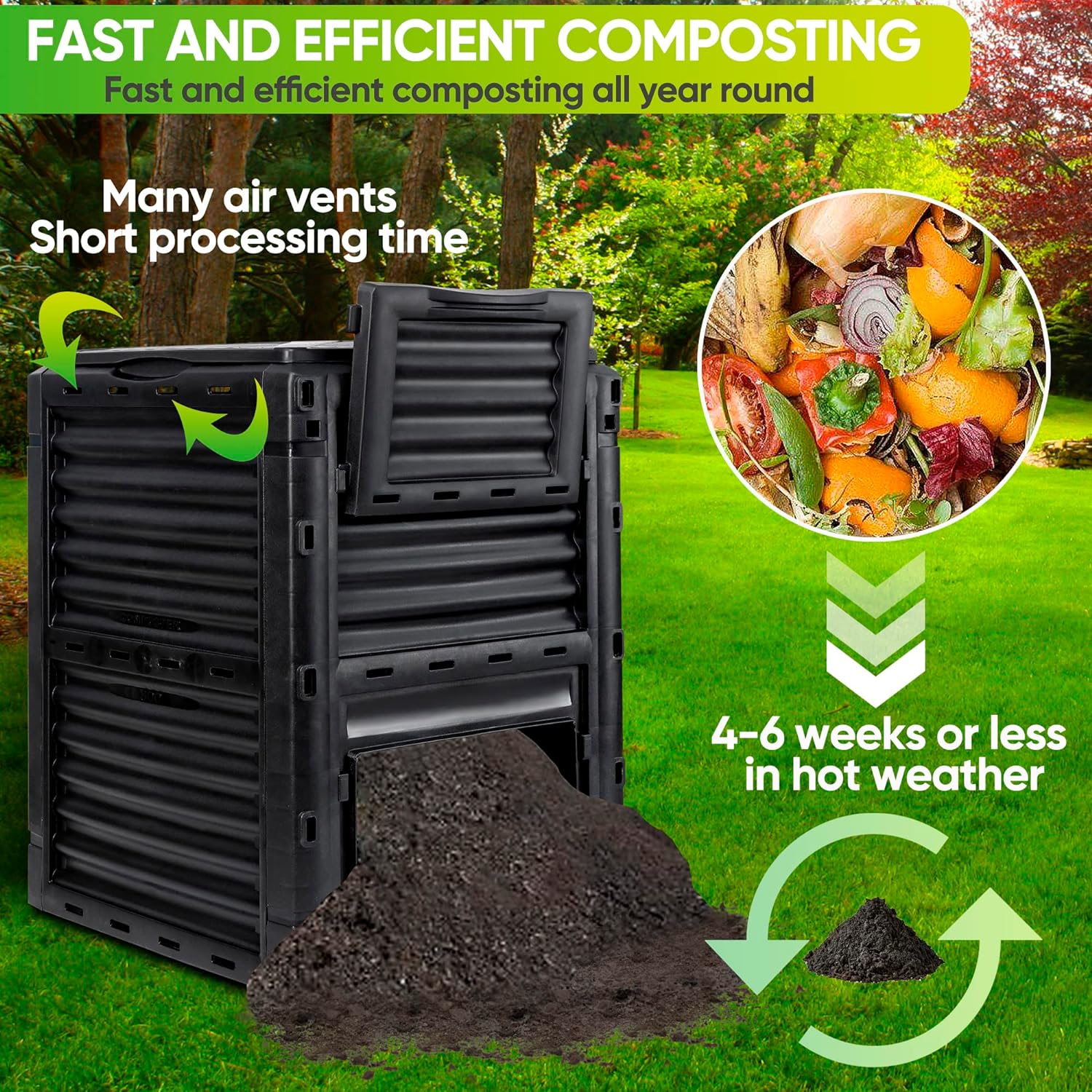
Stationary compost bins are a go-to for many gardeners. They’re simple, they’re sturdy, and they get the job done. You can make one from repurposed materials or buy one made from sustainable resources. Here are some key points to consider:
-
They’re ideal for gardens with space for a permanent composting spot.
-
They come in various materials, including wood and recycled plastic.
-
They require manual turning of the compost, which is a great way to get your daily dose of exercise!
Stationary bins are fantastic if you have the room, but they do require a bit more elbow grease to aerate the compost.
Rotating Tumblers: The Fast Track to Compost
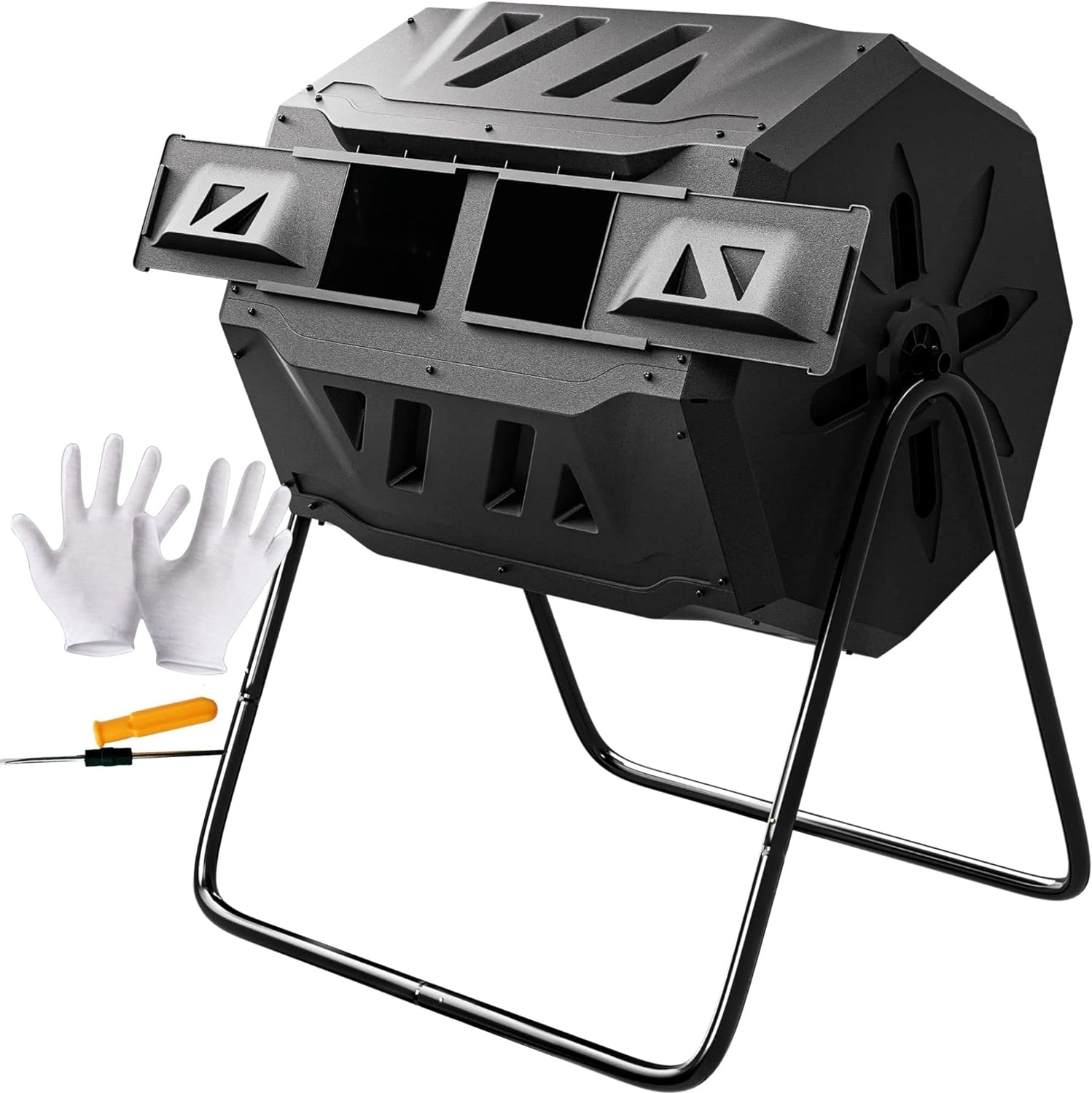
If you’re looking for a quicker turnaround and less physical work, rotating tumblers might be your best bet. These bins sit on a frame and can be turned with a handle, making it easy to mix your compost regularly. This frequent aeration speeds up the decomposition process, meaning you could have ready-to-use compost in as little as a few weeks!
Worm Composters: An Eco-Friendly Solution
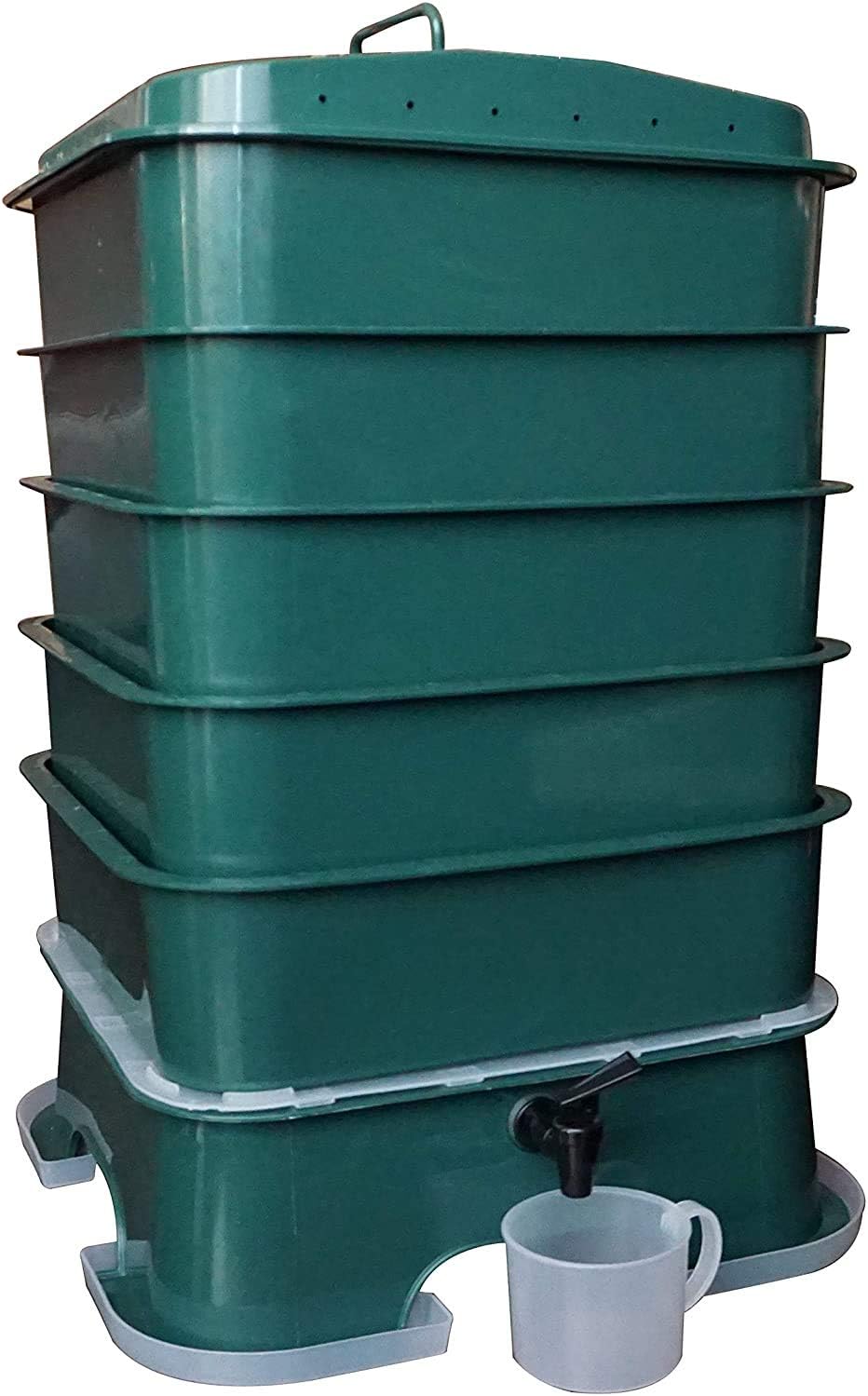
Worm composters, or vermicomposters, are a fascinating and efficient way to compost. These systems use worms to break down organic matter, producing worm castings—a nutrient-rich compost that’s excellent for your plants. They’re particularly good if you’re short on outdoor space since they can be kept indoors without any foul odors.
Key Features of a Good Compost Bin
Now that we’ve covered the types of bins, let’s talk about what makes a compost bin effective. After all, you want to invest in something that will last and do its job well.
Size Matters: Choosing the Right Capacity
The size of your compost bin should reflect the amount of organic waste you produce and the size of your garden. If you have a small balcony garden, a compact worm composter might be perfect. On the other hand, if you have a large vegetable garden, you might need a bigger, stationary bin to handle all your scraps and clippings.
-
A small bin is typically around 30 gallons—great for individuals or small families.
-
Medium bins range from 60 to 90 gallons, suitable for larger households or those with more garden space.
-
Large bins can exceed 100 gallons, designed for serious gardeners with plenty of waste to compost.
Choose a size that won’t overwhelm your space but will still meet your composting needs.
Materials that Last: Durability and Sustainability
When you’re investing in a compost bin, you want one that will stand the test of time. It should be made of sturdy materials that can withstand the elements and the natural process of decomposition. Look for bins made from recycled plastic or sustainably sourced wood, which not only last long but also minimize your carbon footprint. The materials should also be safe for your compost, meaning they shouldn’t leach harmful chemicals into your future garden gold.
Besides that, an eco-friendly compost bin should be constructed to promote good airflow and allow for easy drainage, which are both essential for effective composting. A well-designed bin will save you time and effort in maintenance, and that means more time enjoying your garden.
Setting Up Your Eco-Friendly Compost Bin

So, you’ve chosen your eco-friendly compost bin. Great! Now, let’s set it up for success. The right setup will ensure that your composting process is efficient, hassle-free, and beneficial for your garden.
Location, Location, Location: Where to Place Your Bin
The location of your compost bin can make a big difference. You’ll want to place it in a convenient spot where you can easily add materials. It should be close enough to your garden so you can use the compost without much hassle but far enough to keep any odors from wafting into your home or seating areas. Make sure it’s on a level surface and, if possible, in a spot that gets some sun to help heat up the compost and speed up the decomposition process.
Getting Started: What to Compost and What to Avoid
Composting isn’t just about tossing any old thing into your bin. There’s a bit of an art to it. You’ll want a good mix of ‘greens’ and ‘browns’—that’s compost lingo for nitrogen-rich materials (like vegetable scraps and coffee grounds) and carbon-rich materials (like dried leaves and newspaper). This balance helps your compost break down effectively.
Here’s a quick list of what to compost: For more detailed information, check out our guide on insect-repelling plants to maintain a pest-free garden.
-
Fruit and vegetable scraps
-
Eggshells
-
Coffee grounds and filters
-
Tea bags (make sure they’re not made of plastic)
-
Grass clippings and yard waste
-
Shredded newspaper and cardboard
And some things to avoid:
-
Meat and dairy products (they can attract pests)
-
Fats and oils
-
Pet waste (it can contain harmful pathogens)
-
Diseased plant material
The Art of Maintenance: Tips for Successful Composting
Maintaining your compost bin is key to turning your waste into a valuable resource for your garden. Here are a few tips to keep your compost healthy and productive:
-
Turn your compost regularly to aerate it, which speeds up the decomposition process.
-
Keep your compost moist, but not too wet. The consistency should be like a wrung-out sponge.
-
Chop or shred larger items to help them break down faster.
-
Monitor the temperature. A hot compost pile means things are breaking down well.
-
Be patient. Good compost can take anywhere from a few months to a year to be ready.
Make an Impact: The Environmental Benefits of Composting
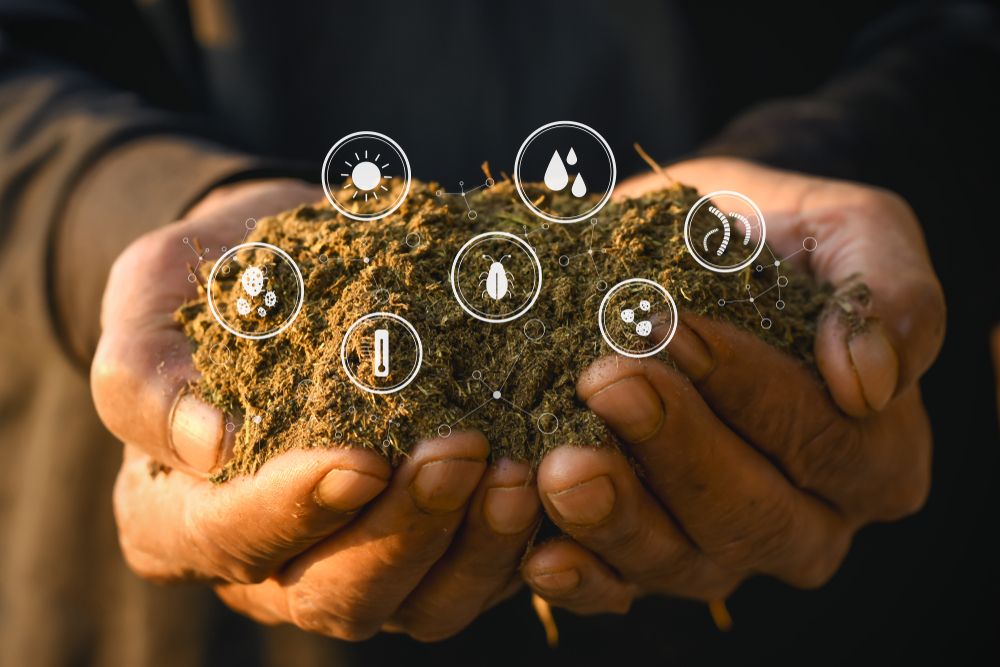
Composting is more than just a boon for your garden—it’s a positive step for the environment. By composting, you’re reducing the amount of waste that ends up in landfills, which is significant because organic waste in landfills contributes to methane emissions, a potent greenhouse gas.
Reducing Waste: How Composting Helps the Planet
Think about this: the EPA estimates that in 2018, about 30% of what we threw away was food scraps and yard waste. Composting these materials instead can dramatically reduce our impact on landfills and the environment. It’s a simple action with a big payoff.
From Soil Health to Your Health: The Ripple Effect
Healthy soil leads to healthy plants, which lead to healthy people. Composting enriches the soil, which in turn helps produce nutritious fruits and vegetables. It also encourages biodiversity in your garden by creating a habitat for beneficial organisms like worms and ladybugs. And let’s not forget the satisfaction and well-being that come from tending to a garden and knowing you’re making eco-friendly choices.
Time to Choose: Popular Eco-Friendly Compost Bins
With so many options on the market, it can be tough to choose the right compost bin. To help you out, here are a few popular eco-friendly compost bins that gardeners love.
FCMP Outdoor HOTFROG Mobile Dual Chamber Tumbling Composter
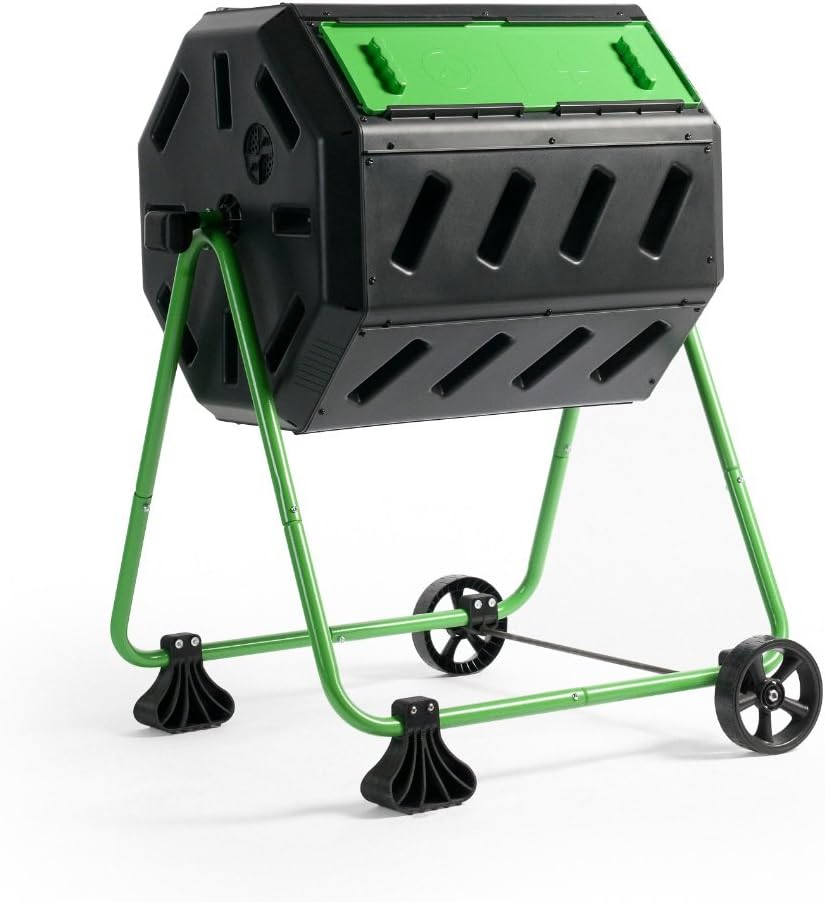
This tumbling composter is a hit for its dual chambers, which allow for continuous composting. It’s easy to turn and speeds up the composting process, plus it’s made from UV-inhibited, recycled polypropylene. It’s a durable and convenient choice for gardeners looking to reduce their ecological footprint. For those interested in eco-friendly gardening practices, consider exploring eco-friendly bright outdoor illumination options to complement your sustainable efforts.
Why it stands out: For those looking to create a sustainable family garden, choosing the right eco-friendly compost bins is crucial. These bins help in reducing waste and enriching the soil, making your gardening efforts more effective and environmentally friendly.
-
Dual chambers for continuous composting
-
Easy to turn and aerate
-
Made from recycled materials
Most importantly, it’s mobile, so you can move it right to where you need your compost.
The Utopia Kitchen Stainless Steel Compost Bin
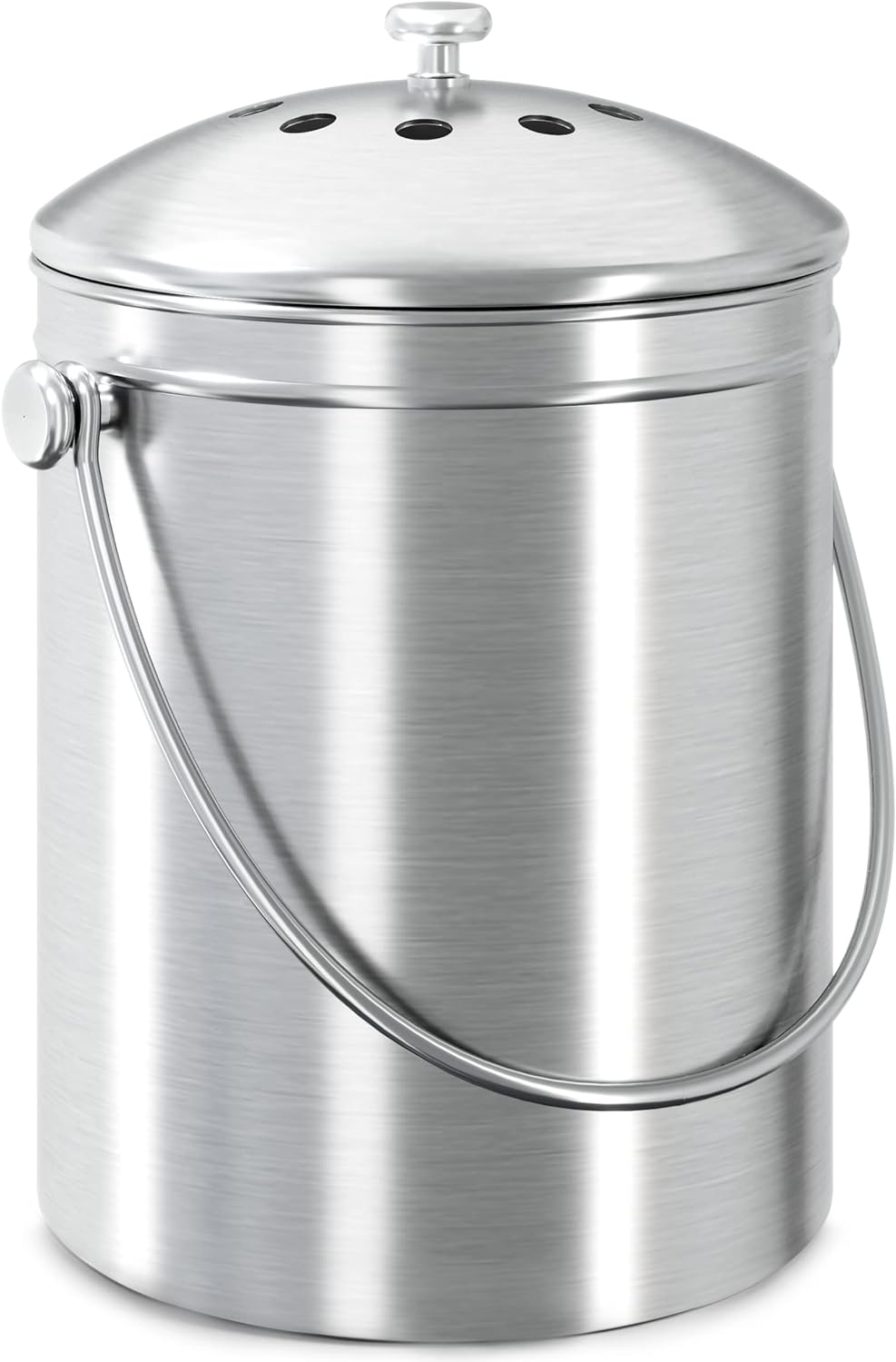
If sleek design and convenience are what you’re after, the Utopia Kitchen Stainless Steel Compost Bin is a fantastic choice. Its compact size makes it perfect for the kitchen counter, allowing you to collect food scraps easily before taking them to your outdoor compost pile. Plus, its stainless steel construction is not only durable but also resists odors and is easy to clean.
Features to love:
-
Stainless steel design that fits seamlessly into modern kitchens
-
Includes a charcoal filter to keep odors at bay
-
Easy to clean and resistant to rust
VermiHut Plus Five-Tray Worm Compost Bin

Worm composting is a fascinating and efficient way to turn your kitchen scraps into high-quality compost. The VermiHut Plus Five-Tray Worm Compost Bin is an excellent choice for those looking to get into vermicomposting. Its stackable tray design allows worms to move upward to fresh food scraps, leaving behind their castings in the trays below, which makes harvesting your compost a breeze.
What sets it apart:
-
Stackable tray system for easy compost management and harvesting
-
Compact design that can be placed indoors or outdoors
-
Odorless operation when maintained properly
FAQs About Eco-Friendly Composting

As we wrap up, let’s address some common questions about eco-friendly composting to ensure you’re well-informed and ready to start turning your waste into garden treasure.
Composting is a straightforward process, but it’s normal to have questions, especially when you’re just starting out. Here are answers to some of the most frequently asked questions to help you compost with confidence.
How do I know which size compost bin is right for me?
Selecting the right size compost bin is all about matching it to your needs. Consider how much kitchen and garden waste you typically produce, and how much space you have. A small bin is perfect for a balcony or small garden, while a larger bin is better for those with more space and more waste. Remember, the goal is to have enough room to manage your waste without the bin becoming too cumbersome.
Can I use any type of materials in a compost bin?
Not all materials are suitable for composting. Stick to organic matter like fruit and vegetable scraps, yard waste, and paper products. Avoid composting meat, dairy, fats, and oils, as they can attract pests and create odor problems. Also, be cautious with diseased plants or weeds that might spread through your compost.
Here’s a simple guide:
-
Do compost: Fruits, vegetables, eggshells, coffee grounds, tea bags, yard trimmings, and non-glossy paper.
-
Don’t compost: Meat, dairy, fats, oils, pet waste, glossy paper, and plastic.
How do I maintain and turn my compost?
Maintaining your compost involves keeping it moist, turning it regularly, and ensuring a good balance of green and brown materials. Turn your compost every week or so to aerate it and speed up the decomposition process. If the compost is too wet, add more browns; if it’s too dry, add more greens or a bit of water.
Why should I pick an eco-friendly composter over a regular one?
-
Eco-friendly composters are often made from recycled or sustainable materials, reducing your carbon footprint.
-
They encourage a more sustainable lifestyle, turning waste into a resource rather than contributing to landfill issues.
-
Using an eco-friendly composter supports the overall health of your garden and the environment.
By choosing an eco-friendly composter, you’re not just investing in your garden—you’re investing in the planet’s future.
Where is the best place to set up my compost bin?
Your compost bin should be placed in a convenient location where it’s easy to add materials and access the finished compost. It should be on a level surface, in a well-drained area that’s partially shaded to maintain temperature and moisture levels. Also, consider the proximity to your garden and kitchen for ease of use.
Remember, composting is a commitment to a healthier garden and a healthier planet. With the right tools and knowledge, you can make a significant impact right in your own backyard. So, roll up your sleeves, choose your eco-friendly compost bin, and start composting today!
When starting a garden, selecting the right tools can make all the difference. For those looking to cultivate their own green space, understanding the essential gardening tools is crucial. From spades and shears to gloves and compost bins, each item serves a specific purpose that can help your garden thrive. Moreover, choosing eco-friendly options not only benefits the environment but also ensures a healthier space for your plants to grow.



